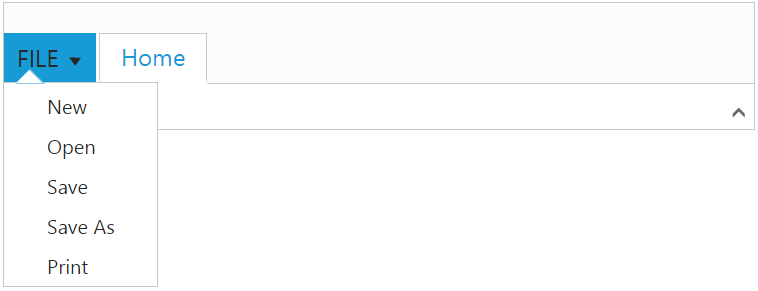Application Tab
27 Aug 201814 minutes to read
The Application Tab is used to represent a Menu that do some operations, such as File menu to create, open, and print documents. Application Tab classified by the following property:
- menu
- backstage
Application Menu
The Application Menu is similar to traditional file menu options and Syncfusion ejMenu control is used internally to render this. To show Application Menu in Ribbon, set the type as menu and menuSettings to customize properties of ejMenu.
Create Using Template
Set the UL element id to e-applicationtab-menuitemid property to create Application Menu and it will acts as template to render menu.
<!DOCTYPE html>
<html xmlns="http://www.w3.org/1999/xhtml" lang="en" ng-app="RibbonApp">
<head>
<title>Essential Studio for AngularJS: Ribbon</title>
</head>
<body ng-controller="RibbonCtrl">
<ul id="ribbonmenu">
<li>
<a>FILE</a>
<ul>
<li><a>New</a></li>
<li><a>Open</a></li>
<li><a>Save</a></li>
<li><a>Save As</a></li>
<li><a>Print</a></li>
</ul>
</li>
</ul>
<div id="Ribbon" ej-ribbon e-width="500px" e-applicationtab-type="menu" e-applicationtab-menuitemid="ribbonmenu">
<e-tabs>
<e-tab e-id="home" e-text="Home"></e-tab>
</e-tabs>
</div>
<script>
angular.module('RibbonApp', ['ejangular'])
.controller('RibbonCtrl', function ($scope) {
});
</script>
</body>
</html>
Backstage Page
The Backstage page is where documents and related data of those can be managed, such as Create, Save and other information.
The Backstage page has a feature to add custom Control in left side of the page which contains menu items and the right side contains corresponding user controls.
To render the Ribbon with the Backstage page, refer to the following code snippet.
<!DOCTYPE html>
<html xmlns="http://www.w3.org/1999/xhtml" lang="en" ng-app="RibbonApp">
<head>
<title>Essential Studio for AngularJS: Ribbon</title>
</head>
<body ng-controller="RibbonCtrl">
<div>
<div id="newCon">
<table>
<tr>
<td>
<button id="btn1" class="e-bsnewbtnstyle">Blank WorkBook</button>
</td>
</tr>
</table>
</div>
<div id="accountCon">
<div class="e-userDiv">
<span>User Information</span>
<div>
<div class="e-accuser e-newpageicon"></div>
<div class="e-userCon">
<div>user</div>
<div>xy@syncfusion.com</div>
</div>
</div>
</div>
<a href="#">Sign out</a>
</div>
<div id="defaultRibbon" ej-ribbon e-width="50%" e-applicationtab="backstage" e-expandpinsettings-tooltip="Collapse the Ribbon" e-collapsepinsettings-tooltip="Pin the Ribbon" e-create="createControl">
<div e-tabs>
<div e-tab e-id="home" e-text="HOME">
<div e-groups>
<div e-group e-text="New" e-aligntype="rows">
<div e-content>
<div e-content e-defaults-type="button" e-defaults-width="60" e-defaults-height="70">
<div e-groups>
<div e-group e-id="new" e-text="New" e-buttonsettings-contenttype="imageonly" e-buttonsettings-imageposition="imagetop" e-buttonsettings-prefixicon="e-icon e-ribbon e-new" e-buttonsettings-click="executeAction">
</div>
</div>
</div>
</div>
</div>
</div>
</div>
</div>
</div>
</div>
<style type="text/css">
.e-blank {
background-image: url("../content/ejthemes/common-images/ribbon/blank.png");
}
.e-infopageicon {
background-repeat: no-repeat;
height: 150px;
width: 198px;
}
.e-newpageicon {
background-repeat: no-repeat;
height: 42px;
width: 42px;
}
.e-bspagestyle {
line-height: 0;
font-size: 30px;
}
.e-ribbon .e-ribbonbackstagepage .e-bsnewbtnstyle {
color: #212121;
background: #fdfdfd;
margin: 20px;
}
</style>
<script>
action1 = ["New", "Clear"],
action2 = ["Bold", "Italic", "Underline", "strikethrough", "superscript", "subscript", "JustifyLeft", "JustifyCenter", "JustifyRight", "JustifyFull", "Undo", "Redo"];
angular.module('RibbonApp', ['ejangular'])
.controller('RibbonCtrl', function ($scope) {
$scope.action1 = action1;
$scope.action2 = action2;
$scope.backstage = {
type: ej.Ribbon.ApplicationTabType.Backstage,
backstageSettings: {
text: "FILE", height: 350, width: 1000, headerWidth: 120, pages: [
{ id: "new", text: "New", contentID: "newCon", itemType: ej.Ribbon.ItemType.Tab },
{ id: "close", text: "Close", enableSeparator: true, itemType: ej.Ribbon.ItemType.Button },
{ id: "account", text: "Office Account", contentID: "accountCon" }
]
}
}
});
$("#btn1").ejButton({
size: "large",
height: 200,
width: 205,
contentType: "textandimage",
imagePosition: "imagetop",
prefixIcon: "e-blank e-infopageicon"
});
</script>
</body>
</html>
NOTE
Height & width of backstage can be set using
heightandwidth, if these are not set, Ribbon’s height & width will be considered.
You can add/remove/update backStage item to the ribbon control by using addBackStageItem, removeBackStageItem and updateBackStageItem methods. Also you can show/hide the backstage page in ribbon control by using showBackstage and [hideBackstage](https://help.syncfusion.com/api/js/ejribbon#methods:hidebackstage methods.